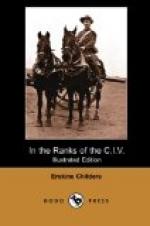“June 3.—Marching-order parade. We had a good morning drill over what is perfect artillery country, with just the right amount of excitement in the shape of ditches to jump, and anthills, which are legion, and holes to avoid. I am delighted with my pair, which are both very fit now; and our waggon team has been going very well.
“June 4.—Riding exercise and sham-fight; an enemy supposed to be attacking a convoy. Being in the convoy, I haven’t a clear idea of what happened, but only know we were kept dodging about kopjes, and bolting across open places uncaptured.
“June 5.—Another field-day, with guns and waggons, before Colonel Davidson, the Brigadier of Artillery here. We went out to some distant kopjes, and went into action at two different points. I believe the shooting was very good; they had targets of biscuit-tins stuck up on the kopjes. Some of you who read this at home may not know how artillery work, so I may as well roughly sketch what happens on these occasions. There are four guns and five waggons. A waggon is built on the same plan as a gun, that is, in two parts, the waggon-body and the waggon-limber, the limber being in front, and having the pole for draught, just as the gun-carriage and the gun-limber form the two parts of the ‘gun.’ Both waggon-body and waggon-limber carry ammunition, as does the gun-limber. There are four gunners on the gun, and four on the waggon. When suitable ground has been selected by the Major, and thoroughly scouted first by the mounted gunners, the order is given to advance into action. The guns trot up in line; ’Action front, right about wheel’ is given, and each swings round, thus bringing the muzzle of the gun to the front. The limber is then unhooked from the trail of the gun, and the teams trot back with the limbers to the rear, leaving the guns to be worked by the gunners. At the same time the signal is sent back to the waggons, who, meanwhile, have been halted in the rear, if possible under cover, to send up two waggons. Two are told off, and they trot up to the firing line. ‘Halt,’ ‘Unhook!’ The wheelers are rapidly unhooked, the team trots back again to the rear. Presently two more are called up with more ammunition. These do the same thing, but after unhooking trot round and hook into the other two (now empty) waggons, and trot them back. The empty waggons are refilled from the mule-waggons, which follow the battery with




